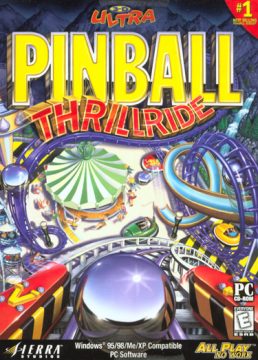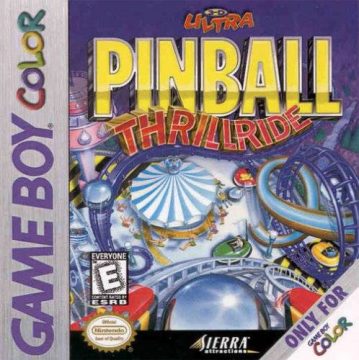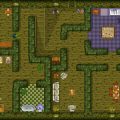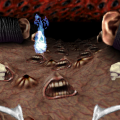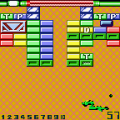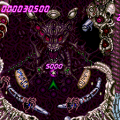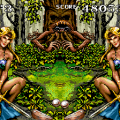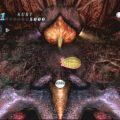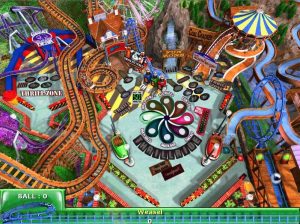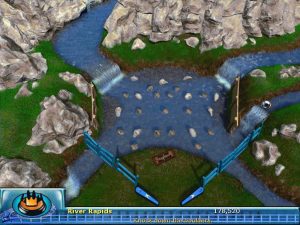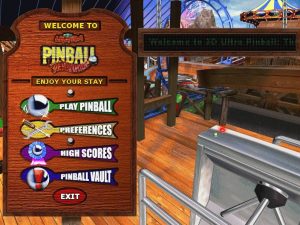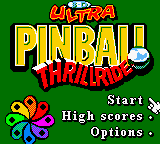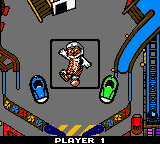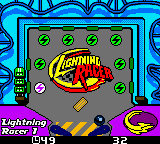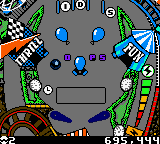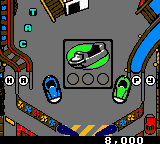- 3-D Ultra Pinball
- 3-D Ultra Pinball: Creep Night
- 3-D Ultra Pinball: The Lost Continent
- 3-D Ultra Pinball: Thrillride
- 3-D Ultra NASCAR Pinball
When Americans think of theme parks, most probably think of Disneyland, or Universal Studios, or Six Flags. 3-D Ultra Pinball: Thrillride, however, focuses on one that has maintained popularity since its founding in 1907: Hershey Park in Hershey, Pennsylvania. Yes, the same Hershey that makes candy bars. Yet despite the connection to one of America’s biggest proprietors of chocolate, the Hershey product placement in Thrillride is actually quite subtle, in the “blink and you’ll miss it” sort of way. Cartoon characters based on Hershey products like Kisses do appear on the scoreboard from time to time, but they don’t get in the way, and the focus of Thrillride is really on the rides and the park itself (the game even has some included videos about the history of the real Hershey Park), not on the chocolate.
Thrillride returns to a somewhat more traditional pinball feel, with a more standard style auto-plunger for launching the ball instead of The Lost Continent‘s swiveling cannon. The goal here is not so much the quest as getting a high score, since the “metagame” is reduced to simply being a vehicle to switch tables. That’s okay though, as it makes Thrillride a more accessible game for casual players.
Also helpful for casual players: in addition to the three difficulty settings, Thrillride offers advanced options that let you customize every aspect of the game rules, from the number of balls per game (anywhere from 1 to 10) to the number of tilt warnings, ball saves, percentage chance of earning extra balls, and frequency of multiball. It also offers the option to add a custom personal message to the game.
Thrillride‘s graphics engine is updated to run the game at 800×600, with support for High-Color displays, which makes the game look far, far smoother, bringing great benefit to the game’s inherently bright and colorful environments (because you wouldn’t want a theme park to consist of browns and greys, would you?). The game also now automatically changes screen resolutions instead of scaling to your display, so there is no more pixelation if your monitor is set higher than 800×600.
Here’s one for the “weird ports” file: Sierra gave Thrillride an adaptation for the Game Boy Color two years later, developed by Left Field Productions (one of only three Game Boy Color games published by Sierra, the other two being casino and card games under the Hoyle license). The Hershey references are made slightly more prominent, and the table layouts have been completely changed to fit in the GBC’s smaller screen. Since the GBC is obviously not capable of the “3D” aspect of 3-D Ultra Pinball, the game is instead presented from a scrolling overhead perspective, similar to Pinball Dreams. The table elements still retain their stylish looks, though, with bumper cars being used as pinball bumpers, roller coaster tracks as ball tracks, and park booths like the snack bar being used for ball catchers. The table-spanning metagame is still present, and table switching is yet more frequent than in the original PC version, since the extra tables along the sides of the “main” table obviously couldn’t make it as they were. That’s certainly not from lack of trying, though, as Left Field obviously put a lot of effort into converting every aspect of the PC version, even down to the cute GBC-style remixes of the original music. Overall, it’s actually quite good, even if it’s almost nothing like the game on which it’s based.
